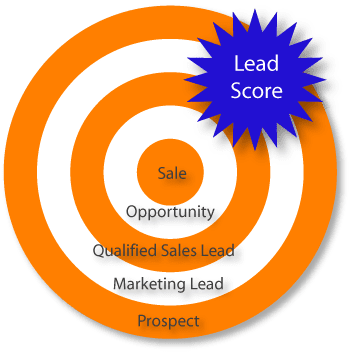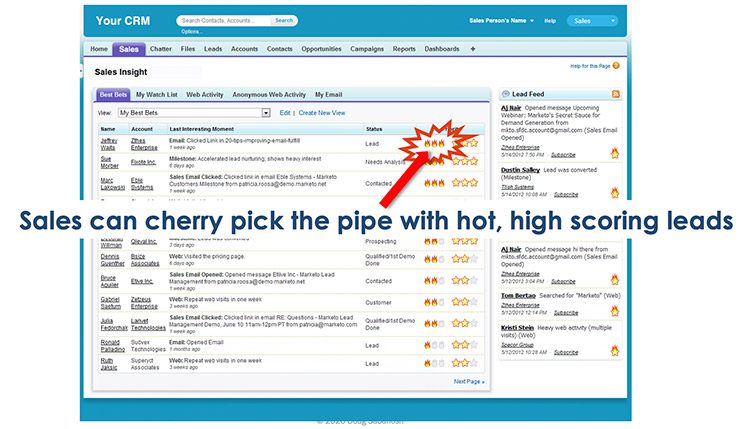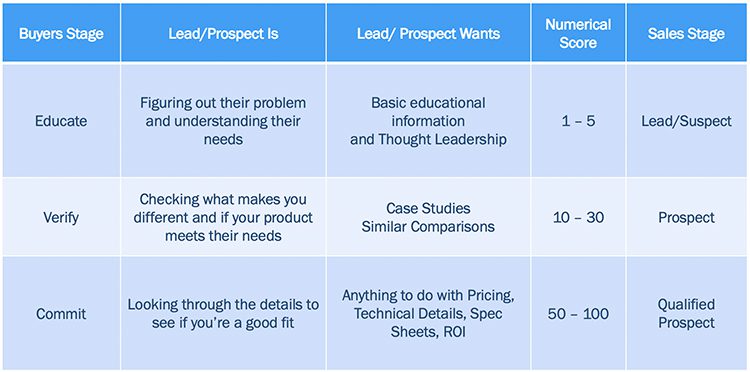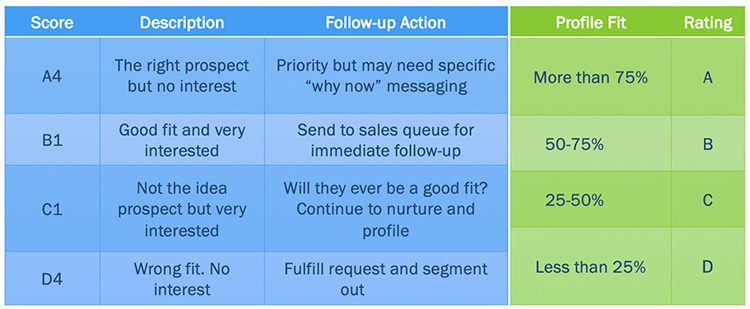Lead Scoring and Why its Important for Business
Please note: Nurtured leads are scored leads. Why nurture them if you’re not going to keep track of them and understand if they’re looking to buy?
Lead scoring is the act of measuring the digital interaction of visitors (a.k.a. leads, prospects, customers, consumers, etc.) with your website and company assets. Lead scoring is a tactic used in the lead nurturing process of marketing. So, what does that mean?
Before we get into the details of what lead scoring is, let’s first identify why we care. It’s pretty simple: lead scoring makes us smarter and more efficient sellers.
The Smart Part
Lead scoring allows you to know more about the people visiting your website, discover the problems they have and the solutions they’re looking for. It also allows you to measure the content, messaging and tactics you’re using to communicate with them. This allows you as a business to focus on who to talk to with and what information works for where they are in their buying process – while marketing more efficiently. In fact, companies that excel at lead nurturing generate 50% more sales-ready leads at 33% lower cost (Marketo).
Nurtured leads make 47% larger purchases than non-nurtured leads.
Nurturing leads helps to score leads – the two are almost one-in-the-same. While you can nurture leads without scoring them, it’s quite difficult to score leads without nurturing them. Marketing automation makes nurturing easier and more efficient by delivering your messages and information on a timely manner or on a decision-based cadence.
Additionally, automation allows you to measure your campaigns and tactics ROI, delivery rates, usage, effectiveness and more.
- Lead nurturing emails get 4-10 times the response rate compared to standalone email blasts (SilverPop/DemandGen Report).
- Companies that automate lead management see a 10% or greater increase in revenue in 6-9 months. (Gartner Research)
Align Sales and Marketing
It’s incredibly important for sales and marketing to work together for lead scoring because it allows them to align the buying cycle with the sales cycle. This brings a better understanding of where the buyer is within each cycle and whether to send them a correlating piece of content or give them a call. Sales and marketing must agree on the value of each piece of content and where it fits in the “funnel.” This is called explicit data. For example: What’s a form fill worth – how many points?
Sales and marketing teams must establish the worth of the personal profile information – called implicit data. For example: What’s an SVP of Product Development worth? It all has to do with the 7-13 people it takes at a major company to make a buying decision (HubSpot). Once you identify those prospects and where they fit in the buying decisions, you can assign a value. Here’s how to do it:
- Identify your ideal customer by creating a persona for each target market. Are they on your “BANTwagon? (Budget, Authority, Need, Time).
- Relevant emails drive 18 times more revenue than broadcast emails (Campaign Monitor).
- Create messaging, content and collateral that informs and describes what your product does and who’s it for.
- Personalized emails improve click-through rates by 14%, and conversion rates by 10% (Campaign Monitor).
- Identify and align both your buyer’s journey and your sales cycle and assign specific messaging, content and collateral to each stage.
- Mapping the customer experience and use of personalized content are deemed the most effective tactics for optimizing marketing automation. (Ascend2)
- Assign value to explicit behavior such as the information directly shared by a lead on a landing page form (job title, company size, location, years of experience, etc.)
- Assign value to implicit behavior such as visited pages, email opens, shared posts, and downloaded content.
- Assign value to website pages (product profiles, contact us, pricing, careers, FAQs) and content and assets (blog, webcasts, demo videos, one-sheets, case studies, etc.).
- Companies with mature lead generation and management practices have a 3% higher sales quota achievement rate.
- Setup a process for marketing to pass leads to sales based on pre-set milestones or achievements that yield the desired benefit – form fills, number of demo videos interacted with, contact requests, number of points a lead has scored etc. This eliminates the need for salespeople to prospect cold leads and gives them more time to concentrate on leads that are looking to buy.
As you go through these processes, your sales and marketing teams will learn more about your company, what they’re selling and to whom they’re selling it. They’ll also recognize how the sales cycle and buyer’s journey align and intersect and what tactics and content work best in each step of the process. Furthermore, it allows the two teams to measure effectiveness of campaigns, content and lead interaction, while identifying what works – and more importantly what doesn’t work.
This process allows marketing teams to identify when a lead is ready and should be passed to sales. Not only doess lead scoring track user engagement, it delivers a digital history and story of what your prospects have interacted with and what they’re looking for right to your CRM. Once the digital history is delivered to the CRM and milestones or achievements are reached, a salesperson has a prioritized call list with information about each lead, giving them some insight into what the lead is looking for. This makes them smarter and more effective – allowing them to act more as a consultant than a salesperson.
If content is King, then conversion is Queen.
- Companies that excel at lead nurturing have 9% more sales reps making quota. (HubSpot)
- Nurtured leads produce, on average, a 20% increase in sales opportunities versus non-nurtured leads. (DemandGen)
- Nurtured leads make 47% larger purchases than non-nurtured leads. (The Annuitas Group)
- 74% of top-performing companies use automated lead nurturing. (HubSpot)
- Lead nurturing can potentially save 80% of your direct mail budget and bring a 10% or greater increase in revenue over 6-9 months (Gartner Research)
How Content Gets Scored
Customize your lead scoring according to the importance of your content and pages. For example, a Contact Us page or a Pricing page will receive a score of 150 because users that visit those pages are showing buying signals. Conversly, a Careers page will receive a score of -150 because a user that visits that page has little interest in making a purchase.
Score leads in three ways:
- A “fit score” quantifies how well a person matches your ideal target.
- An “engagement score” accounts for a lead’s level of interaction with content and thought leadership.
- A “buying intent score” tracks when a lead demonstrates key purchase indicators.
It’s important to score valuable pages and content high, so when a user shows buying signals, the score raises them to the top of the lead list in your CRM. This allows sales people to contact the most interested leads first, rather than spending time on others that are not showing buying signals. Lead scoring can make your sales team more effective and efficient, while closing more deals.
Document the Engagement Score
- Assign values by weighting actions based on recency
- Determine overall ratings
- Create a table that maps out the overall rating of a lead based on percentage of profile fit and engagement level
A – D Score Explicit = Profile Fit of Customer
1 – 4 Implicit Score = Level of Engagement or Interest
Conclusion
Lead scoring is a process used in sales and marketing to assign a value to leads based on certain criteria, such as their level of engagement with your brand or their likelihood to make a purchase. By scoring leads, sales and marketing teams can prioritize their efforts and focus on the most promising leads that are most likely to convert into paying customers.
Here are a few ways in which lead scoring can improve sales and marketing:
1. Focus efforts on the most promising leads: By using lead scoring, sales and marketing teams can identify the leads that are most likely to convert into customers. This allows them to focus their efforts on those leads and avoid wasting time on leads that are unlikely to convert.
2. Improve conversion rates: By focusing on the most promising leads, sales and marketing teams can improve their conversion rates. By tailoring their messaging and approach to the needs of the lead, they are more likely to convert them into a paying customer.
3. Enhance customer experience: Lead scoring can help sales and marketing teams provide a better customer experience. By understanding the needs and interests of each lead, they can provide more personalized and relevant messaging, which can help build trust and loyalty with the customer.
4. Increase revenue: By focusing on the most promising leads, improving conversion rates, and providing a better customer experience, lead scoring can ultimately lead to increased revenue for the business.
In summary, lead scoring can help sales and marketing teams work more efficiently, improve conversion rates, enhance the customer experience, and increase revenue. That’s good for business.
Digital Consulting Services specializes in helping small, medium-sized, and startup businesses grow and operate with modern marketing and sales strategies and tactics.
Digital Consulting Services fills the gaps in existing marketing and sales strategies and operations, and we help execute full-service campaigns that include:
- Sales and Marketing Strategies
- Database Research and Customer Segmentation
- Marketing Automation and CRM Systems Integration
- Demand and Lead Generation
- Lead Scoring and Qualification
- Deal Closing
To learn more about how we can help you grow your business and see if we’re a good fit for your business, feel free to contact us for FREE initial consultation.




